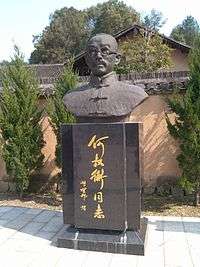Shatian Township
| Shatian Township | |
|---|---|
| Township | |
| Chinese transcription(s) | |
| • Simplified | 沙田乡 |
| • Traditional | 沙田鄉 |
| • Pinyin | Shātián Xiāng |
 Shatian Township Location in Hunan | |
| Coordinates: 28°03′45″N 112°01′57″E / 28.06250°N 112.03250°ECoordinates: 28°03′45″N 112°01′57″E / 28.06250°N 112.03250°E | |
| Country |
|
| Province | Hunan |
| County-level city | Ningxiang City |
| Area | |
| • Total | 74.22 km2 (28.66 sq mi) |
| Population | 34,000 |
| Time zone | China Standard (UTC+8) |
| Postal code | 410643 |
| Area code(s) | 0731 |
Shatian Township (simplified Chinese: 沙田乡; traditional Chinese: 沙田鄉; pinyin: Shātián Xiāng) is a rural township in Ningxiang City, Hunan Province, China. It is surrounded by Longtian Town and Xiangzikou Town on the west, Huangcai Town on the northeast, Liushahe Town on the southeast, and Qingshanqiao Town on the south. As of the 2000 census it had a population of 28,738 and an area of 74.22 square kilometres (28.66 sq mi).
Administrative division
The Town is divided into ten villages: Shatian Village (沙田村), Shisun Village (石笋村), Shuangxi Village (双溪村), Baoyun Village (宝云村), Jinlian Village (金莲村), Hetang Village (合塘村), Duizi Village (堆资村), Xinfei Village (新飞村), Liuzhai Village (六寨村), Shijiang Village (石江村), Changchong Village (长冲村), Wuli Village (五里村) and Shimei Village (石梅村).
Geography
The township abounds in tea oil and rice wine.[1]
Economy
Chinese chestnut is important to the economy.[1]
Culture
Huaguxi is the most influential form of local theater.
Attractions

Huitong Bridge (惠同廊桥), built in the late Qing dynasty (1644–1911).[1]
He Shuheng's Former Residence, built in 1785, in the fifieth year of the Kangxi Emperor, and Xie Juezai's Former Residence, built in the late Qing Dynasty are all scenic spots in the township.[1]
Notable former residents
- Xie Juezai, politician.
- He Shuheng, revolutionary.
- Jiang Mengzhou, revolutionary.
- Xie Nanling, revolutionary.
- Jiang Yaxun, revolutionary.
- Chen Zhongyi, revolutionary.
